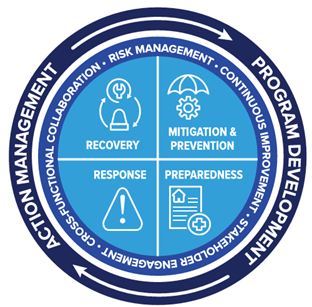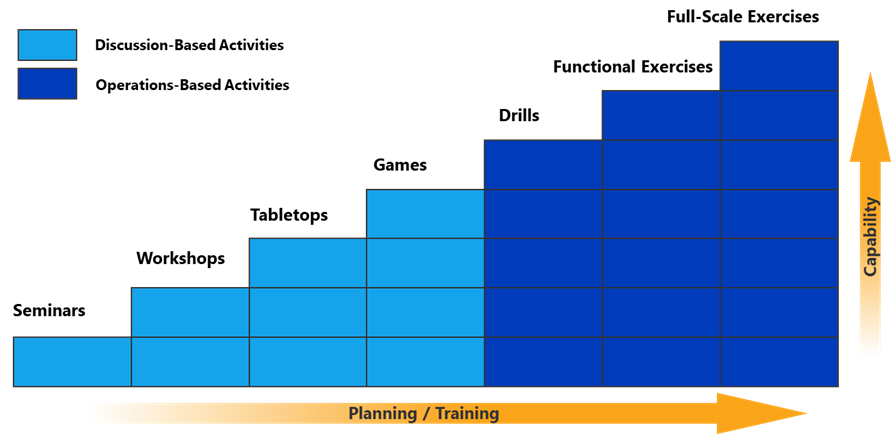Clean Water Current
Safeguarding Our Water: Emergency Response Exercises as a Resilience Validation Tool
By: Steven Dowker, Senior Operational Resilience Professional, Carollo Engineers
I have spent a large portion of my career designing, running, and evaluating emergency response exercises (herein referred to as “exercises) across all levels of government and within the private sector. An effective exercise can provide significant insight into the quality of emergency plans and procedures, coordination mechanisms, and the overall resilience of an organization. Using exercises as a litmus test for overall utility resilience in the water sector is an important task in a landscape facing increasing uncertainty and shifting priorities for emergency and resilience planning.
In a previous blog, my Carollo Engineers colleague Shari St. John briefly discussed the concept of converting resilience from theory to reality through exercises. In this blog, I expand on this and detail how water utilities can integrate exercises as routine training for staff, operators, and local emergency management teams. I share information on important components of exercises and describe how lessons learned result in corrective action plans that support continued improvement of operational resilience programs.
Value-proposition for Resilience

Operational resilience provides water utilities with the ability to take quick and measured actions in the event of an emergency impacting the utility or surrounding community. Comprehensive operational resilience programs are comprised of detailed plans, programs, procedures, and supporting components that ensure the continued delivery of safe drinking water during emergencies. This encompasses emergency response and recovery plans, business continuity plans, risk and resilience assessments, and other targeted plans and procedures. Building resilient infrastructure enhances community well-being by ensuring that the delivery of safe, clean drinking water continues regardless of the operating conditions in the community.
One of the common barriers that water utilities encounter when looking to achieve advanced levels of operational resilience are the financial costs associated with building and validating individual components of their program. This, coupled with the significant day-to-day workloads of staff, means that time and budgets are spent where they provide the highest return on investment. The introduction of America’s Water Infrastructure Act (AWIA) in 2018 was important as it modernized the risk and resilience planning standard for water utilities, and provided a set of standard guidelines that can shift and evolve as the risk and hazard landscapes evolve. The five-year certification cycle detailed in the AWIA legislation establishes a cyclical nature to resilience planning activities and a valuable opportunity to strategically plan for short, medium, and long-term resilience objectives. Leveraging existing planning cycles such as master plans, capital improvement plans, and budgeting cycles, utilities can proactively account for operational resilience projects that compliment infrastructure projects across the utility.
Benefits Derived through Exercises
Understanding your organization’s overall level of resilience requires validation of the plans, procedures, and emergency response mechanisms created as part of your resilience planning process. Exercises are the only opportunity outside of real-world emergencies that staff have a chance to interact with emergency plans and procedures and to build “muscle memory” for emergency response activities. Exercises are also an effective way to reveal gaps in existing plans and procedures and allow for utilities to quickly resolve deficiencies that may exist. The following list details additional benefits derived through conducting regular exercises and a discussion on how they contribute to utility-specific and community-specific preparedness.
- Enhanced Utility Preparedness: By carefully planning and executing exercises that closely align with the results of your Risk and Resilience Assessment (RRA), utilities can identify gaps in response procedures and improve plans, training, and resource preparation. The criticality of evaluating these exercises is discussed in more detail below, but is a critical activity that planners need to consider when building validation exercises. By ensuring that staff within your utility understand the plans and processes that can be used in atypical operating conditions, you can enhance your organizational preparedness and that of your broader community.
- Improved Resource Allocation: Exercises allow utilities to activate plans and procedures, including those specific to resource acquisition and allocation. Scenarios that drive exercise play can include unique information for staff that prompt discussion and action regarding asset allocation and management. The AWIA Emergency Response Plan (ERP) assessment process specifically requires utilities to inventory and describe resources and equipment available to support emergency response actions, and notionally deploying and using these resources during exercises is a way that operational efficiencies and gaps can be identified. Understanding where resources are adequate, and where there may be issues in accessing or procuring equipment, supplies, and other resources is critical for water utilities.
- Streamlined Communication: Effective communication is the foundation of every emergency response. It is imperative that staff understand how communications processes change during emergencies and the additional stakeholders that need to be involved in decision-making under abnormal operating conditions. Evaluating communications and the flow of information during exercises allows staff to learn and explore emergency communication processes in a risk-free environment. This includes the exchange of information internally, externally, and with the media. Being able to test this in a fully contained environment prior to a real-world emergency helps your utility to be prepared.
- Enhanced Trust: Exercises provide a valuable opportunity for showcasing that your utility is prepared to respond to emergencies in a structured way, guided by validated plans and procedures. When your staff possess a strong understanding of your plans and procedures, your response partners and the community at large will have a higher level of trust and confidence in your ability to maintain delivery of a critical lifeline (i.e. water) during emergencies within the community. Joint training and exercises with local emergency management partners is a critical component of increasing water utility and broader community resilience.
It is important to note that while exercises carry a monetary cost, the long-term benefits associated with planning, delivery, and participating in immersive, scenario-based exercises pay long-term dividends. Time (and money) spent preparing staff to effectively respond to emergencies enables your organization to return to normal, or alternate operating conditions quicker, reducing the potential for long-term water delivery issues and subsequent revenue loss, infrastructure loss, or loss through uncoordinated response activities. Various studies, papers, and emergency management doctrine have stated these costs to savings ratios can be anywhere from 1:6 through 1:13 where the return on $1 spent on preparedness activities results in a savings of $6 to $13. While these figures come with varying caveats and nuances, they reinforce the long-term monetary return that your training investments provide. Including emergency management training and exercises in your budgeting process is important and presents opportunities to align budgets with training for existing priorities including health and safety training, safety and security training, and new and refresher training for utility staff.
Technology-Enabled Exercises
Technology has continuously propelled water and wastewater operations, providing opportunities for operational efficiencies, reduction of human error, and augmentation of operator activities. Extending the adoption of technology to support simulation and training exercises enables utilities to provide realistic and immersive activities that build knowledge and understanding of emergency response plans and procedures. Existing technologies leveraged by water utilities provide a platform for hosting immersive simulations that facilitate the delivery of technical scenarios, allowing operators to immerse themselves in the situation. Combining both technical and non-technical teams in exercises enables staff across the organization to access benefits relevant to their expected role during an emergency.
There are several technologies that have been custom-built to design and run immersive simulation exercises. These products facilitate the development of technical and non-technical exercise content and automate delivery of the exercise during conduct. In addition to the benefits provided by design and delivery tools, these technologies can support communications staff by simulating media and social media content that may arise during emergencies. These tools are a valuable addition to your emergency program and can be instrumental in planning and maintaining a formal exercise program for your staff.
Identifying Lessons learned through Key Performance Indicators
A core component of exercises is the evaluation process. The intent of the evaluation during an exercise is not to conduct individual-level evaluation of one or more participants. Rather, the evaluation is intended to be a holistic process that considers how plans, procedures, and processes contribute to an effective response and where these documents may need modifications.
Understanding the specific key performance indicators (KPIs) that you wish to evaluate during the exercise is critical to help guide the design of your evaluation and assessment strategies. These are generally derived from your utilities’ resilience program components, including your ERP, Continuity of Operation Plan (COOP), and/or your RRA. When planning exercises, it is not feasible to evaluate your entire plan and emergency response process; identifying a subset of processes or procedures to evaluate will enhance the value for your organization and allow you to test specific components in manageable pieces. This aligns with the “building block” approach to training and exercises highlighted below, where activities increase in scope and complexity over time. This continuous learning cycle provides value for staff and allows your organization to explore more complex topics as staff skills and knowledge of emergency plans increase.

Strategies for evaluation differ between industries. Through a multi-year exercise program, these evaluations should progressively increase in scope and complexity and assess components of your emergency program based on their criticality to continued operations. Take this further and consider how you integrate a five-year training and exercise cycle to align with the AWIA recertification process. What objectives would you set for your utility after you certify next, what components of your resilience program could use extra attention before the 2030 deadline, and how can you use the next five years to address these shortcomings?
This Sounds Great, but Now What?

Identifying the benefits of exercise programs is step one, but how do you move towards building a bespoke exercise program to meet your organizational needs? What type of training or expertise is required to start building a solution that works for your organization? Luckily, it doesn’t need to be overly complex. Consider what you see as your “blue-sky” scenario – what type of training activities do you think your staff and broader teams could accomplish in three or four years? Do the knowledge, skills, and capabilities exist within your team, or is there a need to provide additional training before moving towards a large exercise? If your end goal is to run a full-scale exercise alongside city or county staff, what building blocks do you need to work on internally so that your staff have the skills and knowledge necessary to respond and integrate into a multi-agency response? These questions should guide how you think about exercise programs and will support with identifying aspects of your emergency response or resilience program that require further development.
In Summary
The discussion above demonstrates that the benefits of an intentional and coordinated approach to exercise planning, delivery, and evaluation is not only an investment in preparedness but also a means of elevating overall performance and resilience of water and wastewater utilities. By using exercises as a primary validation tool for components of our resilience programs we can better fulfill our role in protecting essential public services during times of crisis.
About the Author

Steven Dowker is a Senior Operational Resilience Professional with Carollo Engineers. He has supported dozens of organizations with the implementation of robust emergency management and business continuity programs. His experience spans the public sector in Canada at the Federal, Provincial and local levels, the nuclear sector, and in other highly regulated industries such and oil and gas, and water and wastewater. Working across several industries has contributed to his objectives-based approach to program development that incorporates best practices from various national and international standards, acts and legislation, as well as industry regulations. During the 2020 AWIA certification process, he supported over 30 water utilities with the development of Emergency Response Plans that met and exceeded success criteria laid out in legislation and is currently working with several utilities on their 2025 recertification process.